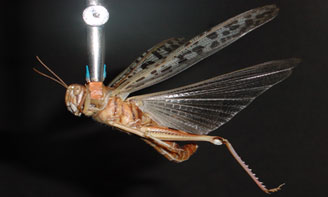
At the moment, there are 2 major projects carried out at the AG Neuroethology:
- development of a telemetric system for neuronal signals
- orientation of solitary and gregarious locusts
Faculty of Biology
Welcome
Research - Animals - Methods - Projects
Staff
Publications
Teaching
Contact
Links
Since the very first experiments employing flying locust in the second half of the 20th century, recordings of neural signals is a standard-testing procedure (Pabst 1965, Wendler 1974). Incidentally, hook-electrode-recordings of nerve N1D2, in which the axon of the pleural wingstretch-receptor is packed, are part of students' practical courses. But so far, all those experiments were conducted with preparations: a locust was anaesthetised; its head, abdomen and legs were removed; the locust was opened, and the hook-electrodes were placed along the nerve (Burrows 1975).
A neuronal hook-electrode using the telemetric system already established for muscles here in Konstanz allows to keep the animal intact: the hook-electrodes are placed during an operation of the anaesthetised and immobilised locust and the transmitter is glued to the animal. Thereby it is possible, for the first time ever, to record neuronal activity in vivo for a free flying and nearly intact animal.
The technique of transmitting neuronal signals with telemetric devices is currently being investigated within a diploma thesis and it will allow a better understanding of nerve-muscle-interactions in flying locusts.
Usually, the migratory locusts are solitary - just as most grashoppers and locusts are. They do normally not interfere with other locust and meet only accidentally and for mating. But optimal climatic and other circumstances lead to gregarization of locusts - swarms with more than a million of animals arise and devastate the areas they approach by wind. These changes of phases were first recognized by Uvarov in 1921. Before that date, people assumed that these two phases represented two different species - due to the different colours, morphometrics and behaviour. But a solitary locust' s eggs can lead to gregarious locusts and vice versa.
In 1940, Franz assumed that different environmental conditions result in the arise of gregarious locusts out of solitary ones. Since the 80's, there is the theory that pheromones can lead the change of lifestyle (Ferenz 1989). Latest research indicates that the stimulation of several receptors at the animal's femur will cause gregarization (Rogers et al. 2003).
A Ph.D.-thesis should investigate several physiological differences in the senseory systems of solitary and gregarious locusts of Schistocerca gregaria and correlate them to the morphological and ethological changes.
Burrows, M (1975): Monosynaptic connections between wingstretch-receptors and flight motoneurons. J. Exp. Biol. 62: 189-219
Franz, J (1940): Phasenwechsel und Massenwechsel bei Wanderheuschrecken. Ztschr. angew. Ent. 26: 64-673
Ferenz, H-J. (1989): Neue Wege zur Heuschreckenbekämpfung - Beeinflussung der Gregarisation von Wanderheuschrecken durch Pheromone. Mitt. dtsch. Ges. allg. angew. Entomol. 7: 141-145
Pabst, H. (1965): Elektrophysiologische Untersuchung des Streckrezeptors am Flügelgelenk der Wanderheuschrecke Locusta migratoria. Z. vergl. Physiol. 50: 498-541
Rogers, SM., Matheson, T., Despland, E., Dodgson, T., Burrows, M., & Simpson, SJ. (2003): Mechanosensory induced behavioural gregarization in the desert locust Schistocerca gregaria. J. Exp. Biol. 206: 3991-4002
Wendler, G. (1974): The influence of proprioceptive feedback of the locust flight co-ordination. J.Comp Physiol. 88: 173-200
